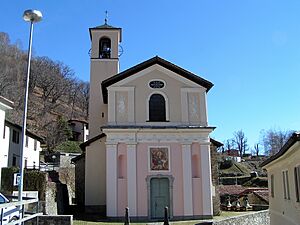Mugena facts for kids
Mugena is a small village in Ticino, a canton (like a state) in Switzerland. It used to be its own municipality (a local government area).
In 2005, Mugena joined with some nearby villages like Arosio, Breno, Fescoggia, and Vezio. Together, they formed a new, larger municipality called Alto Malcantone.
Contents
A Look Back in Time
Mugena was first mentioned in old documents way back in 1214. Back then, it was called Megiadina. Later, in 1270, it was known as Migena.
Ancient Discoveries
One day, people found something amazing by chance! They uncovered an old Roman burial ground. It was a place where Romans cremated (burned) their dead.
During the Middle Ages, the Como Cathedral (a big church) owned land and had rights in the area. They could collect tithes (a kind of tax, often a tenth of farm produce). They also had rights to use the alpine meadows of Nisciora Alp.
Some old papers talk about a castrum. This was probably a supply camp, but experts are still discussing what it really was. In the 1200s, Mugena was part of the Valle d'Arosio. This was a group of villages that worked together. It included Arosio, Breno, Cademario, Mugena, Tortoglio, and Vezio.
The Church of S. Agata
The main church in Mugena is called S. Agata. It was first mentioned in 1361. In 1636, Mugena became a separate church area from Breno. The church was then made into a "vice parish."
The church was renovated and completely rebuilt around the late 1600s. Today, the church has beautiful stucco work from the 1700s. Stucco is a special kind of plaster used for decoration.
Life in the Village
Mugena has kept its old-fashioned, rural look. For a long time, the main ways people earned money were farming and grazing animals. They used the alpine meadows of S. Maria and Cervello for their animals.
Today, most people who live in the valley work in the nearby city of Lugano.
How Many People Lived Here?
This table shows how the population of Mugena has changed over many years:
| Year | Population Mugena |
|---|---|
| 1599 | 180 |
| 1801 | 108 |
| 1850 | 175 |
| 1900 | 157 |
| 1950 | 150 |
| 2000 | 141 |


